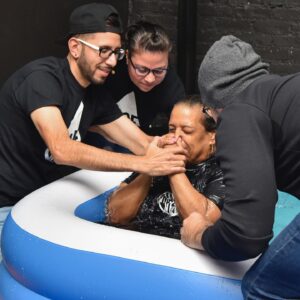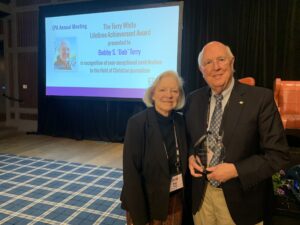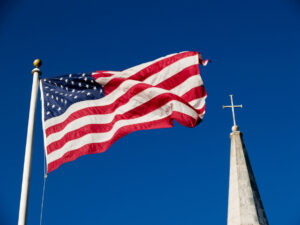
NASHVILLE, Tenn. (BP)–Violence on television has a tendency to affect what teenagers consider socially acceptable behavior, as researchers have said for years, but now a study has found a direct correlation between teens who watch wrestling on TV and those who demonstrate violent behaviors.
The study, published by researchers at Wake Forest University School of Medicine in the August issue of the journal Pediatrics, found that for teens, wrestling was associated with having started a fight with a date, other fighting, having been a date fight victim and carrying a gun or other weapon. Alcohol and drug use also was associated with watching wrestling.
“One of the more interesting things we learned while completing this research was that the relationship between watching wrestling on television and being the perpetrator of dating violence was stronger among females,” Robert DuRant, lead author of the study and professor of pediatrics and social science at Wake Forest, said.
In a random survey of 2,228 North Carolina high school students, researchers found that 63 percent of males and 35 percent of females had watched wrestling on TV within the previous two weeks. Nielsen’s ratings indicate wrestling is one of the top 10 cable TV programs, researchers noted.
Teens who watch wrestling, the study said, are exposed to a high frequency of violence between men and women, alcohol use and hearing women referred to in derogatory terms.
“The level of vulgar language, verbal abuse and physical abuse modeled, with unrealistic outcomes, is astonishing,” DuRant said. “For example, during one wrestling match a man dangled a woman upside down and then dropped her forcibly on her head, knocking her unconscious. In reality, I know this act would have broken her neck and probably would have killed her.
“In addition, the announcer of the program, speculating on what the wrestler was going to do with the woman, stated that she ‘deserved it’ because she had cheated on this wrestler earlier,” DuRant said. “This teaches an adolescent that it is OK to use violence to resolve conflicts and that women deserve abusive treatment.”
DuRant said the study has “tremendous implications” because it shows that “exposure to this type of violence on television during this crucial period of time when a teen’s cognitive, social and physical development is still being cemented can affect adolescents in a negative way.”
Kimberly Thompson, a professor at Harvard University’s School of Public Health, said the research should serve as a warning to parents.
“It’s yet more evidence that, when it comes to kids and media, learning happens,” Thompson, who was not involved in the study, told the Associated Press. “Parents have to pay attention to what’s in their kids’ media diet and what they’re seeing and experiencing.”
YMCA FIGHTS TO KEEP CHRISTIAN IDENTITY — It was founded 150 years ago as the Young Men’s Christian Association, but any mention of Christianity has been dropped from many of the 2,617 YMCA facilities across the nation.
“Unfortunately, people look at us and just see a swim and gym,” John Alexander, executive director of a YMCA in Danville, Ill., told The Tennessean newspaper when 5,000 YMCA leaders convened in Nashville for their national convention in July. “Many people are uncomfortable with religion, and I understand. But it’s a Christian organization. It’s nothing to be ashamed of.”
As part of a renewed effort among some YMCA leaders to re-emphasize the meaning of the letter C in their title, Alexander has added a display of the Ten Commandments, banners with Bible verses and a Bible in the lobby of his facility.
The YMCA’s national mission statement is “to put Christian principles into practice through programs that build healthy spirit, mind and body for all,” but during recent decades, many YMCAs have drafted their own mission statements that don’t mention “Christian” at all, The Tennessean said, and Bible studies and Christian programs have given way to fitness classes, treadmills and recreational programs.
Concerned YMCA directors who want the association to return to its Christian roots have organized the “John 17:21 Project,” based on the verse that was part of the original logo of the YMCA, according to The Tennessean.
But some YMCA staff members and patrons appreciate the fact that the YMCA now is known more as a family fitness center than a Christian outreach program, the newspaper said.
“I think there’s a strong desire at our Y not to be Christian focused,” Amy Amich, membership and marketing director at the McGaw YMCA in Evanston, Ill., told The Tennessean. “Our Y would never think of having biblical verses on the wall. The fear is that people will be put off if we identify as Christian.”
About 20.2 million people are members of YMCAs, and the association’s yearly revenue is just over $5 billion.
2005 SAW INCREASE IN CHARITABLE GIVING — Despite increases in gasoline prices and other necessities, Americans found a way to give 2.7 percent more to charitable causes last year than in 2004, according to a report by the American Association of Fundraising Counsel.
Experts say the increase was propelled by a series of significant natural disasters including Hurricane Katrina and the tsunami in Southeast Asia, The New York Times reported in June.
In 2005, individuals and institutions gave away around $260 billion, and giving to disaster relief accounted for about 3 percent of the total. From December 2004 — when the tsunami hit — to October 2005, about $7 billion was given to disaster relief, the report said.
The Times noted that Americans gave $2.4 billion to the Red Cross and $363 million to the Salvation Army in 2005 to help victims of Hurricane Katrina at a time when the stock market increased only modestly and personal incomes fell for the second year in a row.
“The economic factors we saw last year led us to expect giving would be flatter,” Richard Jolly, chairman of Giving USA, told The Times. “Instead, people gave over and above what we expected in response to the disasters.”
Jolly and others said the intense exposure given to poverty after Hurricane Katrina helped reverse a three-year decline in giving to nonprofit organizations that provide after-school programs, housing for the homeless, substance abuse programs and other human services, The Times reported.
SCHOOLS STRUGGLE TO DECIDE RELIGIOUS HOLIDAYS — Gone are the days when Christmas was the only religion-based holiday school districts had to plan around. Now leaders are struggling to accommodate Jews, Muslims, Buddhists, Hindus and others whose children don’t want to be counted absent when they observe a religious holiday.
Legislators in New York passed a bill earlier this summer that would take all religious holidays into account when scheduling mandatory statewide testing, and the Council on American-Islamic Relations called it the first step toward recognizing Muslim holidays in public schools, the Associated Press reported July 21.
School districts in Michigan and New Jersey already have granted days off on two major Muslim holidays, and school administrators nationwide are spending more time developing their calendars as their student bodies grow more diverse, AP said.
“Either I go against my faith, or I miss my schoolwork and have imperfect attendance,” Kanwal Rehman, a 15-year-old student in Baltimore, told AP.
As a solution to the impractical route of closing down the school on a myriad of religious holidays, some districts are opting to grant “special observance days” when no test or exam can be scheduled and others are giving students “floating” days to celebrate religious holidays with an excused absence.
“‘Choose your own holiday’ has become more popular,” Kathryn Lohre, assistant director of Harvard University’s Pluralism Project, told AP. “It takes pressure off the school boards.”
–30–















